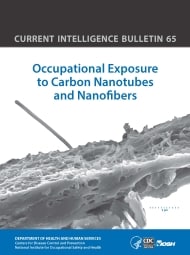Current Intelligence Bulletin 65: Occupational Exposure to Carbon Nanotubes and Nanofibers
April 2013
DHHS (NIOSH) Publication Number 2013-145

The Occupational Safety and Health Act of 1970 (Public Law 91-596) was passed to assure safe and healthful working conditions for every working person and to preserve our human resources. This Act charges the National Institute for Occupational Safety and Health (NIOSH) with recommending occupational safety and health standards and describing exposures that are safe for various periods of employment, including (but not limited to) the exposures at which no worker will suffer diminished health, functional capacity, or life expectancy because of his or her work experience.
NIOSH issues Current Intelligence Bulletins (CIBs) to disseminate new scientific information about occupational hazards. A CIB may draw attention to a formerly unrecognized hazard, report new data on a known hazard, or disseminate information about hazard control. CIBs are distributed to representatives of academia, industry, organized labor, public health agencies, and public interest groups, as well as to federal agencies responsible for ensuring the safety and health of workers.
NIOSH is the leading federal agency conducting research and providing guidance on the occupational safety and health implications and applications of nanotechnology. As nanotechnology continues to expand into every industrial sector, workers will be at an increased risk of exposure to new nanomaterials. Today, nanomaterials are found in hundreds of products, ranging from cosmetics, to clothing, to industrial and biomedical applications. These nanoscale-based products are typically called “first generation” products of nanotechnology. Many of these nanoscale-based products are composed of engineered nanoparticles, such as metal oxides, nanotubes, nanowires, quantum dots, and carbon fullerenes (buckyballs), among others. Early scientific studies have indicated that some of these nanoscale particles may pose a greater health risk than the larger bulk form of these materials.
Results from recent animal studies indicate that carbon nanotubes (CNT) and carbon nanofibers (CNF) may pose a respiratory hazard. CNTs and CNFs are tiny, cylindrical, large aspect ratio, manufactured forms of carbon. There is no single type of carbon nanotube or nanofiber; one type can differ from another in shape, size, chemical composition (from residual metal catalysts or functionalization of the CNT and CNF) and other physical and chemical characteristics. Such variations in composition and size have added to the complexity of understanding their hazard potential. Occupational exposure to CNTs and CNFs can occur not only in the process of manufacturing them, but also at the point of incorporating these materials into other products and applications. A number of research studies with rodents have shown adverse lung effects at relatively low-mass doses of CNT and CNF, including pulmonary inflammation and rapidly developing, persistent fibrosis. Although it is not known whether similar adverse health effects occur in humans after exposure to CNT and CNF, the results from animal research studies indicate the need to minimize worker exposure.
This NIOSH CIB, (1) reviews the animal and other toxicological data relevant to assessing the potential non-malignant adverse respiratory effects of CNT and CNF, (2) provides a quantitative risk assessment based on animal dose-response data, (3) proposes a recommended exposure limit (REL) of 1 μg/m3 elemental carbon as a respirable mass 8-hour time-weighted average (TWA) concentration, and (4) describes strategies for controlling workplace exposures and implementing a medical surveillance program. The NIOSH REL is expected to reduce the risk for pulmonary inflammation and fibrosis. However, because of some residual risk at the REL and uncertainty concerning chronic health effects, including whether some types of CNTs may be carcinogenic, continued efforts should be made to reduce exposures as much as possible.
Just prior to the release of this CIB NIOSH reported at the annual meeting of the Society of Toxicology [03/11/2013] preliminary findings from a new laboratory study in which mice were exposed by inhalation to multi-walled carbon nanotubes (MWCNT) [see https://blogs.cdc.gov/niosh-science-blog/2013/03/11/mwcnt/]. The study was designed to investigate whether MWCNT have the potential to initiate or promote cancer. Mice receiving both an initiator chemical plus inhalation exposure to MWCNT were significantly more likely to develop tumors (90% incidence) and have more tumors than mice receiving the initiator chemical alone. These results indicate that MWCNT can increase the risk of cancer in mice exposed to a known carcinogen. The study did not indicate that MWCNTs alone cause cancer in mice. This research is an important step in our understanding of the hazards associated with MWCNT, but before we can determine whether MWCNT pose an occupational cancer risk, we need more information about workplace exposures, the types and nature of MWCNT being used in the workplace, and how that compares to the material used in this study. Research is underway at NIOSH to learn more about worker exposures and the potential occupational health risks associated with exposure to MWCNT and other types of CNTs and CNFs. As results from ongoing research become available, NIOSH will reassess its recommendations for CNT and CNF and make appropriate revisions as needed.
NIOSH urges employers to share this information with workers and customers. NIOSH also requests that professional and trade associations and labor organizations inform their members about the potential hazards of CNT and CNF.
Current Intelligence Bulletin 65: Occupational Exposure to Carbon Nanotubes and Nanofibers [PDF – 3.41 MB]
